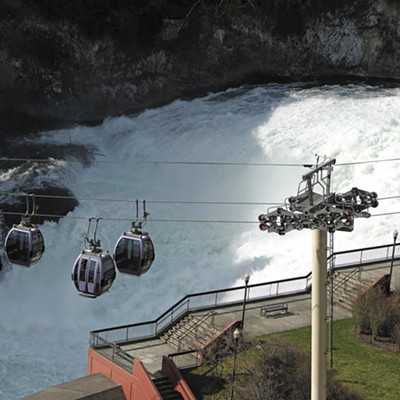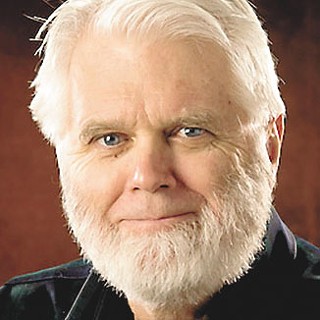Focus on the Local
[
{
"name": "Broadstreet - Instory",
"insertPoint": "5",
"component": "25846487",
"requiredCountToDisplay": "5"
},{
"name": "Broadstreet - Instory",
"insertPoint": "10",
"component": "25846487",
"requiredCountToDisplay": "10"
},{
"name": "Broadstreet - Instory",
"insertPoint": "15",
"component": "25846487",
"requiredCountToDisplay": "15"
},{
"name": "Broadstreet - Instory",
"insertPoint": "20",
"component": "25846487",
"requiredCountToDisplay": "20"
}
]
by Robert Herold
Worrisome indeed is the Spokesman-Review's most recent reduction-in-force, another significant cut in senior and experienced newsroom staff. I'm one who believes that our community should benefit from having a locally owned daily newspaper of record, and I'm gratified that changes in leadership have greatly improved the paper's editorial page.
To be sure, not all the changes get high marks. The paper's self-conscious pandering to demographics has resulted in a semi-lurid new arts and entertainment section that transforms "cool" into "hokey." The section has about as much style, integration and sophistication as an underground high school newsletter. Here you have serious writers such as Dan Webster and Jim Kershner forced to keep company with syndicated sex columnists. That's not cool. On a brighter note, however, special kudos to whomever it was who determined to give Rebecca Nappi her voice. Her column is terrific and shows what can be done when talent, position and opportunity are matched.
All these changes at the Review come as part of a larger struggle, a struggle that has engaged daily newspapers across the country. Today the public is awash with news options. And no doubt, the S-R continues to suffer, uniquely, from the credibility it lost because of its self-admittedly compromised coverage of the River Park Square garage fiasco. Jim Camden's apologetic series came too little and too late to have done much more than confirm suspicions.
But, as observed by a West Side reporter who was in town a few years back preparing an article on the garage issue, the paper has never covered "breaking news" all that well. This observer had nice things to say about the Review's feature stories; so, how was it, he asked, that this news organization could hire good people, pay them well and do a good job on features -- but fail to cover the news? After all, in his mind, wasn't breaking news fundamental to what a paper was all about?
To illustrate the problem, consider just the issue of Sunday, June 27. The front page featured five articles. The headline piece was written by a staff reporter, as were two fluff pieces about Hoopfest. But the other front-page articles? They were provided by the Associated Press and Knight-Ridder. Once inside the section, the Review all but disappears. The second page carried just one article, courtesy of the Washington Post. On page three, three articles -- one each from the Chicago Tribune, Washington Post and Los Angeles Times. It gets no better on pages four and five, where we find five articles, all provided by news services. The next two pages contained articles from the Washington Post, Knight-Ridder and the Los Angeles Times. Seven more articles complete the primary news section of the paper; all are provided by news services.
Turning to the Regional section, on the front page are four homegrown articles plus Doug Clark's column. Turn the page, and the Review, again, disappears. Page two features six articles, all provided by the Associated Press. Two more articles complete the section -- one from the Associated Press, one from the Moscow-Pullman Daily News.
The In Life section repeats the pattern. The feature article is written by an S-R reporter, and that's pretty much that. Articles from USA Today, the Fort Worth Star-Telegram, the Associate Press and Knight-Ridder and the Lexington-Herald Leader complete the section. And this pattern is repeated even in section that is most local in interest, the sports section.
So yes, we have a locally owned newspaper, but ours relies so heavily on work done elsewhere that "locally owned" is fast becoming irrelevant to content and coverage. What's worse, the
S-R plays a losing hand. Every day we read news stories in the S-R that can be found online -- often days earlier. If I can easily replicate on my eMac more than 80 percent of the news appearing in the entire Sunday issue, so too can everyone else. Local coverage is the only way to counter the effects of so much news being so readily available through so many different media.
It isn't as if we don't have local stories begging to be covered as only a daily can. (The Inlander, a weekly, is not the newspaper of record and doesn't have the space to fill the void.) Consider: The Spokane River has almost gone critical, yet we see very little about the relationship between water pollution and a continuing and expanding pattern of development in the Spokane Valley over to Coeur d'Alene. The Metropolitan Mortgage meltdown is our city's version of Enron, yet following some early coverage, the story has faded. Is coverage of the so-called "University District" ever to reflect more than boosterism? Then we had the homeless demonstration. Wouldn't it have been helpful to learn something more about these people and their problems? This issue could still stand much more work. On the local political front, as John Roskelley and Kate McCaslin move on to other challenges, the homebuilders and other interests have launched their bid to take control of the county -- at the exact time the river (see above) and growth management (if you can call it that) beg for strong, disinterested and visionary leadership.
These and many other stories fall into the breaking news category. But does the paper have the staff necessary to do the job, even were its leadership to make such coverage a priority? The worry is that the leadership doesn't and won't. Worse yet, maybe it can't.
Comments? Send them [email protected]
Publication date: 07/29/04
Worrisome indeed is the Spokesman-Review's most recent reduction-in-force, another significant cut in senior and experienced newsroom staff. I'm one who believes that our community should benefit from having a locally owned daily newspaper of record, and I'm gratified that changes in leadership have greatly improved the paper's editorial page.
To be sure, not all the changes get high marks. The paper's self-conscious pandering to demographics has resulted in a semi-lurid new arts and entertainment section that transforms "cool" into "hokey." The section has about as much style, integration and sophistication as an underground high school newsletter. Here you have serious writers such as Dan Webster and Jim Kershner forced to keep company with syndicated sex columnists. That's not cool. On a brighter note, however, special kudos to whomever it was who determined to give Rebecca Nappi her voice. Her column is terrific and shows what can be done when talent, position and opportunity are matched.
All these changes at the Review come as part of a larger struggle, a struggle that has engaged daily newspapers across the country. Today the public is awash with news options. And no doubt, the S-R continues to suffer, uniquely, from the credibility it lost because of its self-admittedly compromised coverage of the River Park Square garage fiasco. Jim Camden's apologetic series came too little and too late to have done much more than confirm suspicions.
But, as observed by a West Side reporter who was in town a few years back preparing an article on the garage issue, the paper has never covered "breaking news" all that well. This observer had nice things to say about the Review's feature stories; so, how was it, he asked, that this news organization could hire good people, pay them well and do a good job on features -- but fail to cover the news? After all, in his mind, wasn't breaking news fundamental to what a paper was all about?
To illustrate the problem, consider just the issue of Sunday, June 27. The front page featured five articles. The headline piece was written by a staff reporter, as were two fluff pieces about Hoopfest. But the other front-page articles? They were provided by the Associated Press and Knight-Ridder. Once inside the section, the Review all but disappears. The second page carried just one article, courtesy of the Washington Post. On page three, three articles -- one each from the Chicago Tribune, Washington Post and Los Angeles Times. It gets no better on pages four and five, where we find five articles, all provided by news services. The next two pages contained articles from the Washington Post, Knight-Ridder and the Los Angeles Times. Seven more articles complete the primary news section of the paper; all are provided by news services.
Turning to the Regional section, on the front page are four homegrown articles plus Doug Clark's column. Turn the page, and the Review, again, disappears. Page two features six articles, all provided by the Associated Press. Two more articles complete the section -- one from the Associated Press, one from the Moscow-Pullman Daily News.
The In Life section repeats the pattern. The feature article is written by an S-R reporter, and that's pretty much that. Articles from USA Today, the Fort Worth Star-Telegram, the Associate Press and Knight-Ridder and the Lexington-Herald Leader complete the section. And this pattern is repeated even in section that is most local in interest, the sports section.
So yes, we have a locally owned newspaper, but ours relies so heavily on work done elsewhere that "locally owned" is fast becoming irrelevant to content and coverage. What's worse, the
S-R plays a losing hand. Every day we read news stories in the S-R that can be found online -- often days earlier. If I can easily replicate on my eMac more than 80 percent of the news appearing in the entire Sunday issue, so too can everyone else. Local coverage is the only way to counter the effects of so much news being so readily available through so many different media.
It isn't as if we don't have local stories begging to be covered as only a daily can. (The Inlander, a weekly, is not the newspaper of record and doesn't have the space to fill the void.) Consider: The Spokane River has almost gone critical, yet we see very little about the relationship between water pollution and a continuing and expanding pattern of development in the Spokane Valley over to Coeur d'Alene. The Metropolitan Mortgage meltdown is our city's version of Enron, yet following some early coverage, the story has faded. Is coverage of the so-called "University District" ever to reflect more than boosterism? Then we had the homeless demonstration. Wouldn't it have been helpful to learn something more about these people and their problems? This issue could still stand much more work. On the local political front, as John Roskelley and Kate McCaslin move on to other challenges, the homebuilders and other interests have launched their bid to take control of the county -- at the exact time the river (see above) and growth management (if you can call it that) beg for strong, disinterested and visionary leadership.
These and many other stories fall into the breaking news category. But does the paper have the staff necessary to do the job, even were its leadership to make such coverage a priority? The worry is that the leadership doesn't and won't. Worse yet, maybe it can't.
Comments? Send them [email protected]
Publication date: 07/29/04



















